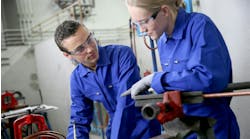Latest from Management
Sponsored
The 1980s brought forth the first condensing gas-fired appliances we dealt with: 92% efficiency furnaces. Those first-generation condensing furnaces had more than their share of glitches, which gave us a few more gray hairs while customers chewed us a new behind on more than a few occasions! Having not dealt with combustion=produced condensate previously, we either piped that to a nearby floor drain or to the outdoors using a condensate pump. That first winter, we learned — the hard way — that an ice plug in the pump’s termination line led to either a no-heat call when the safety float interlock broke the power to the furnace, or condensate overflow that often soaked items stored nearby. Oops.
On average, we were told in classes, it is possible to produce a gallon of condensate for every 100,000-Btus combusted per hour. No one gave any thought to the fact that the condensate was “mildly acidic.” Before long, we noticed the concrete where condensate was allowed to drain onto its surface was becoming etched. In addition, cast iron floor drain covers would be eaten through.
The pH scale runs from 0 to 14 with seven being neutral. Any number below seven is acidic while numbers above seven are alkaline. Mildly acidic would be six or above. If you have a pH test kit or meter, you can clearly determine the actual pH of combustion-produced condensate ranges from two to five on the pH-scale! That’s more acidic than battery acid.
Natural gas or propane combust using air-borne oxygen and will form water vapor that prior to high-efficiency appliances, was kept in vapor form up through and out of the chimney to the great outdoors. Providing the hot gasses remained above approximately 350°F, condensing would only briefly occur on start-ups, unless you had an unlined brick chimney with multiple feet exposed above the roofline where severe damage to the cement and soft bricks could plainly be witnessed.
Once we dropped the outgoing exhaust gasses below 350°F in order to extract more useful indoor comfort-energy, masonry chimneys could no longer be used and indirect venting (exhaust to exterior while combustion air is drawn from inside the home) or direct venting (both exhaust and combustion intake are piped to the exterior).
You might ask: Why is the condensate so acidic? Great question! Nitrogen, the largest component of the combustion air (70% by volume), is taken along for the combustion process ride and forms NO (nitrous oxide) and NO2 (nitrogen dioxide) both of which readily dissolve into the condensate being produced to become nitric acid. You have probably heard about NOX combustion byproducts, which refer to NO & NO2.
National, and local, codes often mandate combustion-produced acidic condensate be treated at the source to affectively raise the pH to above five with seven being the ideal target.
As plumbers, you have no doubt seen the damage to cast iron drainage lines downstream of commercial kitchens and/or grease traps. A ribbon of cast iron no longer present running along the bottom of the piping. The exact same thing occurs in cast iron piping that has been exposed to long-term exposure to acidic combustion-produced condensate.
In the past we have made up our own acid neutralizers using 3” PVC with a solvent-weld cap on the bottom and cleanout plug on the top to add neutralizer. Drilling/tapping the sides for the bottom inlet and top outlet with C-clamps installed on unistrut for wall-mounting. The same neutralizer used for aggressive well-water can be utilized, but make sure it’s the blend used for the most aggressive low-pH water.
No need these days to waste the time making your own acidic condensate neutralizer as virtually every manufacturer now sells ones designed to last for 12- to 18-months that can be recharged with media during your annual maintenance service calls.
You might have a newer home with all PVC drainage lines and that may well discharge to SDR-35 PVC sewer mains, but sewage treatment plants are seeing a spike in acidity in the waste stream that’s causing degradation of metallic components. National, and local, codes often mandate combustion-produced acidic condensate be treated at the source to affectively raise the pH to above five with seven being the ideal target.
Septic systems can see the necessary bacteria cultures compromised if sufficient quantities of low-pH acidic condensate are introduced. Here again, a wee bit of education for Mr. & Mrs. Homeowner can go a long way in helping you to sell this inexpensive upgrade to your high-efficiency systems.
Handling the disposal of both the acidic condensate and air conditioning coil condensate (which can also be adversely affected by air-born indoor air contaminates) can be relatively simple by discharging treated condensate to a floor drain or pumped to a safe-waste like the clothes washer stand-pipe. Drilling a hole in the basement concrete floor and directly discharging condensate into the earth is a short-cut that should be avoided by professionals.
Aside from the snot-pool deposited under the floor, radon can easily be drawn in by the air-handler if the evaporator coil cabinet trap dries out during winter or, as is too often seen, no trap was installed. As air passes by the condensate collection gutter under the AC coil, negative pressure is created (Venturi affect), which will draw in air through the condensate drain.
Dave Yates material in print and on Contractor’s Website is protected by Copyright 2016. Any reuse of this material (print or electronic) must first have the expressed written permission of Dave Yates and Contractor magazine. Please contact via e-mail at: [email protected].
Dave Yates
Dave Yates material in print and on Contractor’s Website is protected by Copyright 2017. Any reuse of this material (print or electronic) must first have the expressed written permission of Dave Yates and Contractor magazine.


